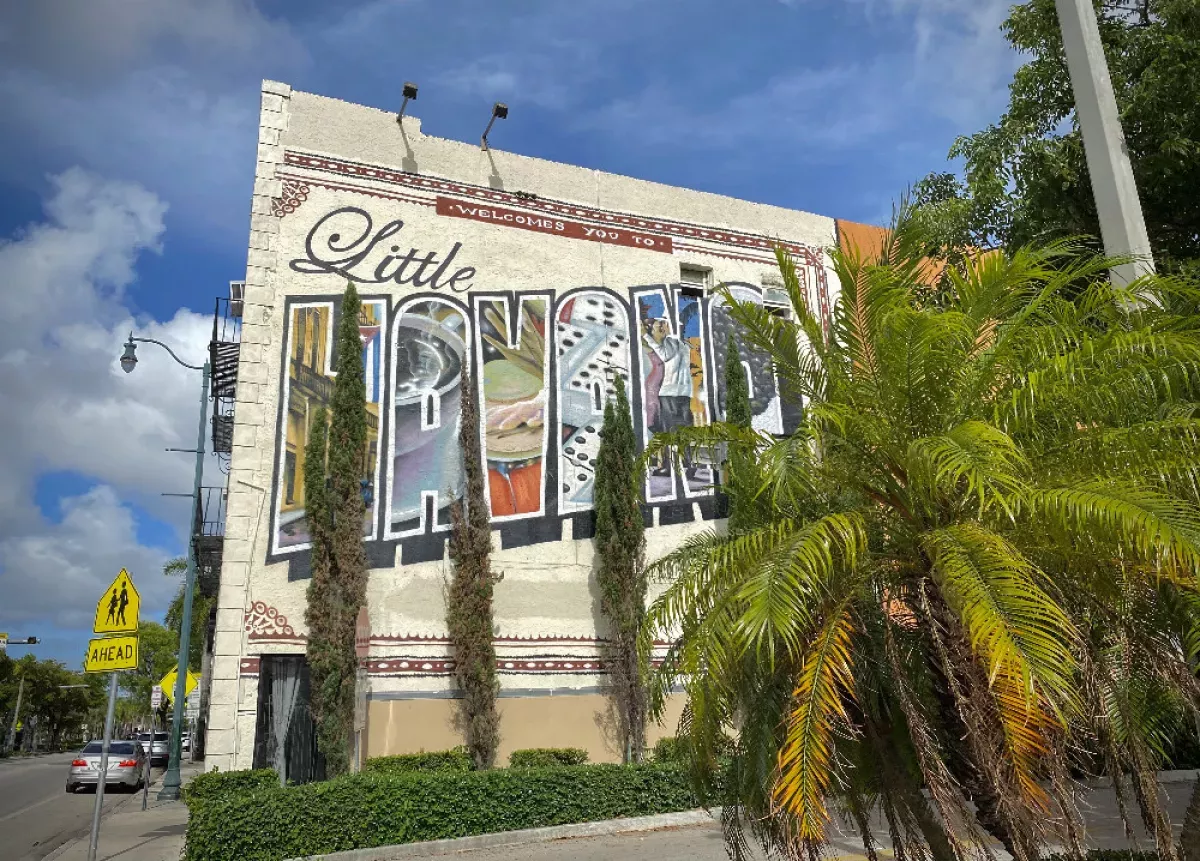Miami is a coastal city located in Florida, United States. As of the 2020 census, the city had a population of 442,241, while the Miami metropolitan area in South Florida is estimated to have 6.46 million residents, making it the sixth-largest metropolitan area in the U.S. Miami features the third-largest skyline in the United States, boasting over 300 high-rises, with 70 exceeding 491 feet in height. It also serves as the county seat of Miami-Dade County.
1900: Miami's population in 1900
In the 1900 census, Miami's population was 1,681.
February 3, 1917: Record low temperature in 1917
On February 3, 1917, Miami recorded its historical low temperature of 27 °F (-2.8 °C).
1922: Coral Way built in 1922
Coral Way, a historic residential neighborhood, was built in 1922 between Downtown and Coral Gables.
1925: Coconut Grove annexed into Miami in 1925
In 1925, Coconut Grove, originally settled in 1825, was annexed into Miami.
1925: Tornado in 1925
In 1925, a tornado struck Miami.
1926: The 1926 Miami Hurricane
In 1926, the Miami Hurricane slowed development in Miami.
1940: Miami's population in 1940
By 1940, Miami's population had increased to 172,172 people due to World War II.
July 21, 1942: Record high temperature in 1942
On July 21, 1942, Miami recorded its historical high temperature of 100 °F (38 °C).
1950: Miami's population in 1950
In the 1950 census, Miami's population was 249,276, making it Florida's largest city.
1956: Start of the observation period for summer in Miami
From 1956 to 1997, the date summer began in Miami ranged from April 16 to June 3, with a median date of May 21.
1959: Cuban Revolution in 1959
In 1959, following the Cuban Revolution led by Fidel Castro, many wealthy Cubans sought refuge in Miami, which increased the city's population.
1970: Miami population in 1970
By the 1970 census, Miami's population reached 334,859.
1970: Miami's Population Demographics in 1970
In 1970, the Census Bureau reported Miami's population as 45.3% Hispanic, 32.9% non-Hispanic White, and 22.7% Black.
1972: 1972 Events in Miami
In 1972, Miami hosted both the Democratic and Republican National Conventions during the Presidential election. The Miami Dolphins also had their undefeated perfect season in 1972.
January 19, 1977: Snow flurries in Miami in 1977
On January 19, 1977, snow flurries fell in some parts of Miami, the only recorded snowfall since records have been kept.
1978: Calle Ocho Festival
Since 1978, the Calle Ocho Festival, the largest Latin music festival in the country, has been held in Miami.
1985: Miami elected its first Cuban-born mayor
In 1985, Xavier Suarez became Miami's first Cuban-born mayor.
1988: Last Republican Win
The last time a Republican candidate had won Miami-Dade County since 1988.
December 1989: Coldest daytime temperature recorded in 1989
In December 1989, during the December 1989 United States cold wave, Miami recorded its coldest daytime maximum temperature of 45 °F (7 °C).
1990: Peak of Non-Hispanic Black Population in 1990
In 1990, Miami's non-Hispanic Black population peaked at almost 90,000, making up nearly a quarter of the city's population.
1996: Miami Jewish Film Festival Established
In 1996, the Miami Jewish Film Festival (MJFF) was established as an annual event.
1997: End of the observation period for summer in Miami
From 1956 to 1997, the date summer ended in Miami ranged from September 24 to November 1, with a median date of October 17.
1997: Tornado in 1997
In 1997, a tornado struck Miami.
2000: Nadir of Non-Hispanic White Population in 2000
At the time of the 2000 census, the non-Hispanic White population of Miami reached a low point of 11.8%.
2000: Miami population in 2000
By the time of the 2000 census, Miami's population stood at 362,470.
2000: Population growth from 1970 to 2000
From 1970 to 2000, population growth in Miami was stagnant, with non-Hispanic White Miamians leaving and significant immigration from Latin America, particularly Cuba.
2000: Miami population growth started
In the 2000s, Miami's population began to grow quickly again.
2001: Miami Government Bankrupt
In 2001, the local government of Miami went bankrupt, marking a significant financial challenge for the city.
2002: Republican Candidate since 2002
Before 2022, the last time a Republican Candidate had won in Miami-Dade county was in 2002.
2003: Miami Hosts Free Trade Area Negotiations
In 2003, Miami was the host city for the Free Trade Area of the Americas negotiations.
2007: Rudest Drivers in the United States
In 2007, Miami was identified as having the rudest drivers in the United States, marking the second consecutive year it received this citation.
2007: Housing Market Crash and Foreclosure Crisis
The housing market crash of 2007 triggered a foreclosure crisis in Miami, impacting the area significantly.
September 2008: Student Enrollment
In September 2008, Miami-Dade County Public Schools had a student enrollment of 385,655 and over 392 schools and centers.
2009: Univision Studios
In 2009, Univision announced plans to build a new production studio in Miami, called Univision Studios.
2010: Increase of Non-Hispanic White Population in 2010
At the time of the 2010 census, the non-Hispanic White population of Miami rose slightly to 11.9%.
2010: Miami population in 2010
From 2000 to 2010, Miami's population grew by 10.2% and reached 399,457 in 2010.
2010: Asian Ancestry in Miami in 2010
In 2010, 1.0% of Miami's population was of Asian ancestry.
2010: American and Arab Ancestry in Miami in 2010
In 2010, 1.9% of Miami's population considered themselves to be of only American ancestry, while 0.5% were of Arab ancestry.
2010: Origin of Miami Residents in 2010
In 2010, 34.4% of Miami residents were of Cuban origin, 15.8% had a Central American background, 8.7% were of South American descent, 4.0% had other Hispanic or Latino origins, 3.2% descended from Puerto Ricans, 2.4% were Dominican, and 1.5% had Mexican ancestry.
2010: West Indian and Afro-Caribbean American origin
In 2010, 5.6% of city residents were West Indian or Afro-Caribbean American origin, 3.0% were Black Hispanics, and 0.4% were Subsaharan African origin.
2010: Miami Ranked 44th Most Bike-Friendly City
In 2010, Bicycling Magazine ranked Miami as the 44th-most bike-friendly city in the U.S., highlighting the city's support for bicycling for recreation and commuting.
2010: College Graduates in Miami
In 2010, Miami's four largest colleges and universities, including Miami Dade College and Florida International University, graduated 28,000 students.
2010: Miami Intermodal Center Completion
The Miami Intermodal Center, a transportation hub servicing various modes of transport, was completed in 2010.
November 2011: Opening of New Norwegian Seamen's Church Building
In November 2011, Crown Princess of Norway Mette-Marit opened a new building for the Norwegian Seamen's Church in Miami. The church serves as a center for Scandinavians living in Florida.
2011: Telemundo Filming in Miami
In 2011, 85% of Telemundo's original programming was filmed in Miami, highlighting the city's significance as a television production center.
2011: Miami Ranked Eighth Most Walkable City
In 2011, a Walk Score study ranked Miami as the eighth-most walkable of the 50 largest cities in the U.S.
2012: Poverty Levels in Miami
In 2012, Miami had the fourth-highest percentage of family incomes below the federal poverty line among large cities in the United States.
2012: Miami Central Station Expected Completion
In 2012, the Miami Central Station was expected to be completed, aiming to centralize Amtrak operations with other transportation hubs.
2013: Miami's Gross Metropolitan Product in 2013
In 2013, Miami had a Gross Metropolitan Product of $257 billion, ranking 11th in the United States and 20th worldwide.
2013: Newspaper Headquarters Relocation
In 2013, The Miami Herald and El Nuevo Herald, Miami's main newspapers, relocated from Downtown Miami to the former home of U.S. Southern Command in Doral.
2014: Religion in Miami in 2014
In 2014, according to a Pew Research Center study, Christianity was the most practiced religion in Miami (68%), followed by Judaism (9%).
2014: Port of Miami Tunnel Opens
In 2014, the Port of Miami Tunnel opened, connecting the MacArthur Causeway to PortMiami, improving access to the port.
2014: Miami Central Station Completion Delayed
The Miami Central Station's completion, initially expected in 2012, was delayed and later expected to be completed in late 2014.
2015: US Census data from 2015 to 2019
According to the U.S. census data collected between 2015 and 2019, Miami has some deficiencies.
2015: Households Without Cars
In 2015, 19.9% of city of Miami households were without a car.
2015: Formula E Race Hosted
In 2015, Miami hosted a one-off Formula E race, adding to its history of hosting professional auto races.
2015: Tri-Rail Phase II Completion
In 2015, the Tri-Rail part of Phase II of MiamiCentral Station was completed.
2015: Miami Central Station Completion Further Delayed
The Miami Central Station completion, previously expected in late 2014, was pushed back again to early 2015 due to further delays.
2016: Archbishop Curley-Notre Dame High School Closure
Archbishop Curley-Notre Dame High School, located within the Miami city limits, closed in 2016.
2016: Tourism in Miami
In 2016, Miami attracted the second-highest number of foreign tourists of any city in the United States.
2016: Commuting and Car Ownership
In the 2016 American Community Survey, 72.3% of working city of Miami residents commuted by driving alone and 18.6% of city of Miami households were without a car.
2016: Shift to the Right
In the 2016 presidential election there was a 21 point shift to the right.
2017: Miami's Gross Domestic Product in 2017
In 2017, Miami's metropolitan area had a gross domestic product of $344.9 billion, making it the largest urban economy in Florida.
2017: PortMiami Cruise and Cargo Activity
In 2017, PortMiami served 5,340,559 cruise passengers and imported 9,162,340 tons of cargo, solidifying its status as a major cruise and cargo port.
2017: Visitors Arrive in Miami
In 2017, more than 15.9 million visitors arrived in Miami, contributing $26.1 billion to the economy.
2017: ParkScore Ranking Change
In the 2017 ParkScore ranking, the park system in the City of Miami was ranked 48th, showing a slight decrease in the 2020 ranking.
2018: Growth of downtown Miami population
Between 2010 and 2018, the downtown Miami population, from Brickell north to Midtown Miami, grew nearly 40%.
2018: Miami's ranking in UBS study in 2018
In a 2018 UBS study, Miami was ranked as the third-richest city in the U.S. and globally in purchasing power.
2019: US Census data from 2015 to 2019
According to the U.S. census data collected between 2015 and 2019, Miami has some deficiencies.
2019: Miami Open Moves to Hard Rock Stadium
In 2019, the Miami Open, an annual tennis tournament, moved to Hard Rock Stadium after being purchased by Miami Dolphins owner Stephen Ross.
2020: Report on at-risk cities in 2020
According to a 2020 report by Resources for the Future, Miami is one of the most at-risk cities globally due to climate change.
2020: Miami as a Beta + level world city in 2020
According to the 2020 ranking of world cities by the Globalization and World Cities Research Network (GaWC), Miami is considered a Beta + level world city.
2020: Miami's Hispanic and Latino population in 2020
As of 2020, Miami's Hispanic and Latino population was 310,472, which is 70.2 percent of the city's total population.
2020: Miami's population in 2020
In 2020, Miami had a population of 442,241 according to the census. The Miami metropolitan area had an estimated 6.46 million residents, making it the sixth-largest metropolitan area in the United States.
2020: Boat-in Movie Theater Opens
In 2020, Miami's first boat-in movie theater opened, offering a unique entertainment experience.
2020: ParkScore Ranking
In its 2020 ParkScore ranking, The Trust for Public Land reported that the park system in the City of Miami was the 64th best park system among the 100 most populous U.S. cities.
2020: Non-Hispanic Black Population in 2020
In the 2020 census, Miami's non-Hispanic Black population was 52,447, only 11.7% of the population.
2020: Presidential Election Turning Point
The 2020 presidential election marked a turning point in Miami-Dade County, with Trump making gains among Hispanic voters.
2021: Miami Homeless Count in 2021
In 2021, there were 555 unsheltered homeless people on the streets in the city limits of Miami.
2022: Citadel Relocates to Miami
In 2022, Citadel LLC and Citadel Securities, a hedge fund and a market maker respectively, relocated their headquarters from Chicago to Miami.
2022: Miami-Dade County Homeless Count in 2022
In 2022, a Point-In-Time Homeless Count showed that there were 3,440 homeless people in Miami-Dade County, 970 of whom were on the streets.
2022: Miami's visitor count in 2022
In 2022, the Miami metropolitan area had over four million visitors, making it the second-most visited metropolitan statistical area in the U.S. after New York City.
2022: Gubernatorial Election
In the 2022 Florida gubernatorial election, Ron DeSantis won Miami-Dade county for the first time for a Republican candidate since 2002.
July 2024: Miami Hosted Copa América Final
In July 2024, Miami hosted the Copa América final.
2024: Presidential Election in Florida
The 2024 presidential election in Florida showed a continued trend, with Trump winning Miami-Dade County by eleven points.
2025: Film Awards
As of 2025, the Miami Jewish Film Festival (MJFF) awards a number of film awards.
2026: Miami to Host FIFA World Cup
Miami will serve as one of the eleven U.S. host cities for the 2026 FIFA World Cup.
2070: Projected Sea level rise by 2070
By 2070, Miami's sea level is projected to rise by 21 inches (53 cm) to 40 inches (100 cm).
Mentioned in this timeline

Ron DeSantis is an American politician currently serving as the...

The Miami Dolphins are a professional American football team based...

Hard Rock Stadium located in Miami Gardens Florida is a...
Florida a southeastern U S state is a peninsula between...

A car also known as an automobile is a wheeled...
Telemundo is an American Spanish-language terrestrial television network owned by...
Trending
Merrill Kelly is an American professional baseball pitcher currently playing for the Arizona Diamondbacks in MLB He debuted in MLB...

1 month ago James Carville criticizes Fox News and Trump in Martha MacCallum interview.

1 day ago Luka Don?i? Reveals Body Transformation After Intense Offseason Training: 'Body Looks Better'

2 months ago Mirra Andreeva vs. Yulia Putintseva at French Open; Putintseva Advances to Second Round

12 days ago Cerúndolo Advances to Swedish Open Semi-Final, Chasing Alcaraz's Clay-Court Wins
2 months ago Chandler Simpson: Rays' speedster steals bases, making history in his first games.
Popular

The Boeing Dreamliner is an American wide-body airliner developed by...

Jeff Hardy is an American professional wrestler currently signed with...

John Michael Ozzy Osbourne is a prominent English singer songwriter...

Jupiter is the fifth and largest planet from the Sun...

Jeff Bezos is an American businessman renowned as the founder...

Candace Owens is an American political commentator and author known...
